I’m Levi Byrne, and I’m honored to have the chance to write for Dear Azami this week. (And to follow the mental image of mallet-wielding octopi that Dave conjured up in last week’s article!) Longtime Dear Azami readers might remember me from when Cassidy retooled my Avacyn deck a few years ago, but for the rest of you, let me introduce myself as a full-blown Commander addict. I have a bad habit of changing my decks so frequently that sometimes I don’t even get a chance to play with the new additions before they find their way out. I’ve been reading Dear Azami for almost as long as I’ve been playing Magic, and I attribute much of my growth as a deckbuilder to the lessons I learned reading Sean’s early articles. Most of all, I’m looking forward to my chance to help people who are in the same place as I was when I first started.
The best way to describe my playstyle is… varied. Early on I made it a point to build every archetype I could think of and see what felt right. My current wheelhouse of decks includes everything from Mono-Black Control with Visara the Dreadful to Krenko, Mob Boss’s army of Goblin tokens and everything in between. Whatever my decks do, though, I try to make them capable of creating the kind of crazy stories that make Commander special. You know, stuff like pointing thirty instant-speed Valakut triggers at my opponent’s face in response to a lethal Comet Storm.
Now, let’s get into the decks. Maybe something nice and easy to start with…
Dear Azami,
Recently, I have been messing around with commanders, and nothing I own can beat my Sliver Overlord deck. This is my attempt to change that.
Upon realizing that I had a lot of artifacts and about as many blue cards that worked well with aforementioned artifacts, one commander came to mind.
At first I thought it was too evil. I searched and searched for something else, something that would not make all of my friends hate me. Nothing came up.
Ergo, I was left with having to build Memnarch. I tried to make gaining control of my opponent’s entire deck only a subtheme though, instead focusing on
artifacts and support. Without further ado, here is my deck
Commander: Memnarch
14x Island
This deck is currently a guilty pleasure of mine, as it works really well in my current metagame, which is mostly Bant Control and that one oddball
Progenitus deck. Aside from being able to interact with Progenitus, this deck can do almost anything my opponents can. It has a few fun combos such as
Clever Impersonator cloning my Well of Ideas, but it mostly revolves around things like Blightsteel Colossus and Colossus of Akros to actually win. I am
looking for an Inkwell Leviathan, but no one I know has one.
Simply put, I want this deck to win, but be kinda fun about it. I hereby challenge you: make Memnarch a fun deck to play with in Multiplayer!
Faithfully reading,
Ed
Or not. When it comes to commanders, Memnarch is a powerhouse that often gets overlooked because anyone competitive enough to enjoy the mad metal wizard
will usually go for the indisputably Tier One commanders like Sharuum or Edric. Making a strong Memnarch deck is fairly easy. Making one that’s also fun is
a whole other challenge, but that’s what I signed up for, so let’s get started.
You said you wanted the deck to focus on artifact synergy and support cards instead of abusing your Ccommander’s ability to the fullest extent possible, so
that’s where I’m going to take the deck. Hopefully by the time I’m done you’ll be more interested in Memnarch’s first ability than his second one. You’ll
be left fairly weak to mass destruction effects like Creeping Corrosion and Merciless Eviction, but you have a fair number of counterspells to stop these
cards from ruining your day. And considering that artifacts’ slice of the color pie is basically defined as “make mana” and “interact with other
artifacts,” I think the resulting power will be well worth it.
To start off with, the list you sent me has 101 cards, so we’ll have to cut a card somewhere to get it down to 99+1. Now, onto the changes:
The Creatures
Out:
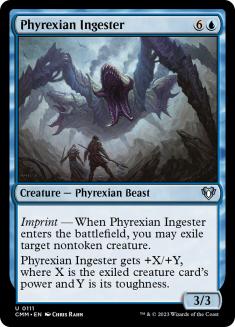
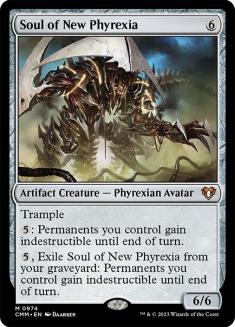

These are both solid cards that serve dual roles, but they aren’t filling either well enough to justify including. Ingester isn’t an artifact, and seven is
just a little more than you want to pay for a piece of removal that doesn’t synergize with the rest of the deck. Soul of New Phyrexia has an absurdly
strong effect, but holding up five colorless all the time hurts a lot, especially given how mana-hungry your deck is. Personally, I cut the Soul from my
decks after I kept getting blown out by removal in response to activating the ability. It’s getting cut for something a little more reliable.
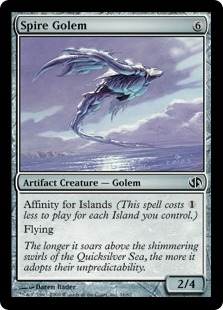
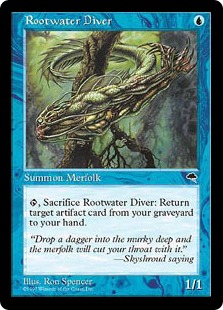

Spire Golem is cute, but even the dream scenario of casting it on turn 2 off of a Sol Ring and two Islands is just underwhelming in Commander. More likely
it would land around turn 4 or 5 given how many nonbasics you’re running, and there’s definitely stronger things to be doing by that point. Out it goes.
Rootwater Diver does do something you’d want access to, but I don’t think it’s worth a spell slot just for that one-shot ability.
In:
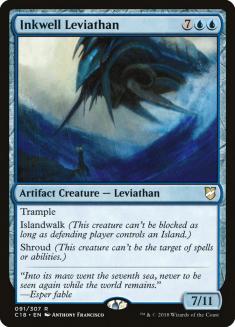
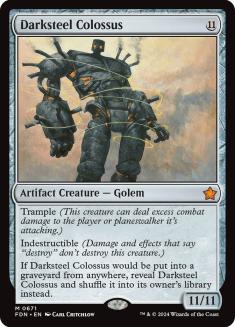
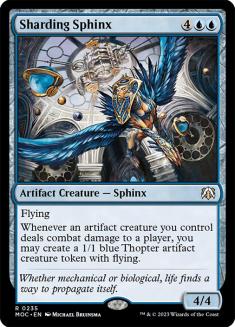

You pointed out that you usually rely on either Colossus of Akros or Blightsteel Colossus to win, so these guys come in to give you better odds of finding
your threats faster. They’re all evasive and resilient against removal in some way, which means they’ll usually make a decent impact before someone deals
with them. You said you’ve been looking for an Inkwell Leviathan, so I added it and you can use part of the $20 store credit you’ll receive for your
participation today – no need to worry about trading for it! Darksteel Colossus was a fairly obvious inclusion since you’re playing both his big and little
brothers already. I’ve had mixed results with Sharding Sphinx, but if there’s a player without air defense, those Thopters can multiply beyond control very
quickly.
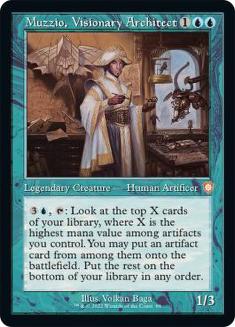

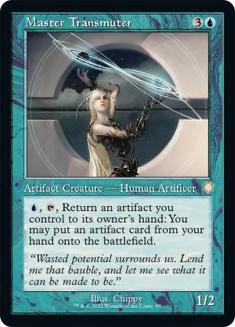
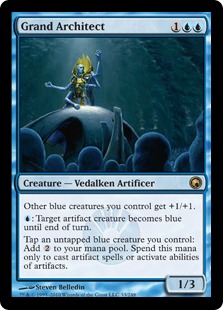
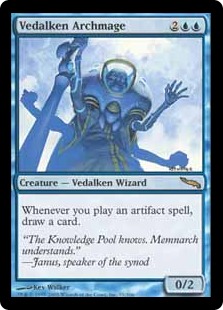

These guys are here for the “Artifact Synergy” theme, and I can say from experience that they are very potent at what they do. Muzzio, Arcum Dagsson, and
Master Transmuter all let you circumvent the mana costs of your lategame spells, which is important when you plan to win with creatures that cost anywhere
from eight to twelve. Grand Architect is included for similar reasons, and his abilities combine to generate a lot of mana very quickly. Remember that you
can still tap creatures with summoning sickness to activate his third ability. Vedalken Archmage is a powerful card advantage tool that’s on-theme. He has
a fragile body, but most removal in Commander is unconditional anyway. In the games where he sticks around he can pretty easily bury your opponents in free
cards.
If you want, Muzzio or Arcum Dagsson could also replace Memnarch as your commander with a few minor tweaks to the list. I’m not going to recommend you make
the change or build around either of them, but since you said Memnarch was the only legend that you thought of when you started building blue artifacts, I
felt obligated to point out some of your other options.
These aren’t the only creatures I’ll be adding in, but since the rest of them are essentially being included as artifacts that happen to be creatures, I’ll
talk about them in the artifacts section.
The Planeswalkers
Out:
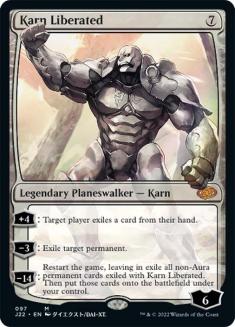
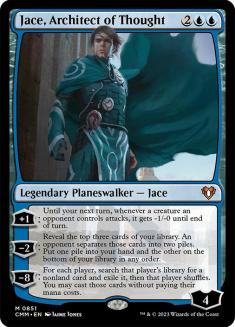

This Jace doesn’t do anything particularly impressive in Commander. His plus is a minor deterrent to attacks, but Commander is a format of truly gargantuan
numbers and any army big enough to be threatening without this effect will still run you over despite the damage reduction. His minus is some okay card
advantage, but you’re in blue. There are better options that don’t require you to protect them. His ultimate is both powerful and irrelevant, as ultimates
rarely see the light of day outside of Doubling Season shenanigans.
I’m a little iffier on cutting Karn since he’s obviously one of the most powerful planeswalkers ever printed. But once you evaluate him in the context of
this format, he doesn’t look nearly as good. Without the ability to reliably activate his ultimate, his plus is effectively identical to the original
Liliana’s. Let’s face it, that’s not exactly why people run her. Karn’s minus one of the best pieces of removal you can ask for, and the fact he loses
fewer counters than his plus gains him is part of what makes him so good. But when you almost always drop him to three the turn he comes out, I’m willing
to bet that someone will have enough evasion to take him out before you get to use him a second time. At least in an artifact deck, Spine of Ish Sah does
everything Karn wants to do and is on-theme.
In:
Nothing!
As a general rule I’m not a fan of planeswalkers in Commander unless you’re literally building a deck around protecting them, so I don’t see a need to add
any more. Tezzeret only stayed in because he’s directly on-theme and will usually begin by replacing himself with at least one card. In the end, these are
more slots freed up for other sections.
The Spells
…AKA the “things that don’t scale well to Commander” section. Most of the support cards you run are very strong Constructed cards that simply don’t stack
up well in a format where mana is abundant, and one-for-ones simply aren’t good enough against
multiple opponents. I’m going to be slashing this section pretty drastically as a result, but trust me when I say that the changes will make your deck a
lot stronger.
Out:
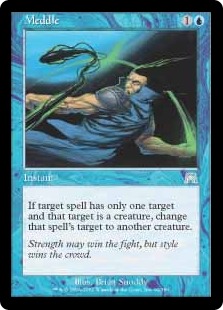
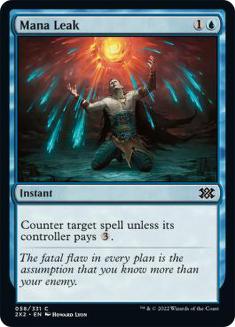
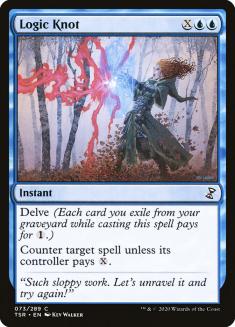
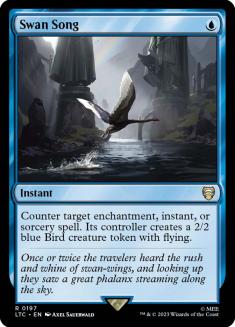
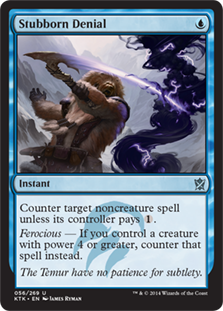
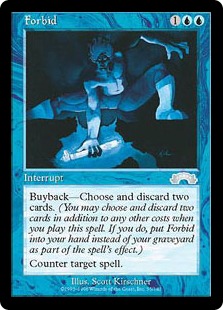

The list you sent me ran ten counterspells, and it dipped into some pretty questionable ones to do it. Unless your whole metagame is made up of decks that
do nothing but race for infinite combos, I don’t see the need for anywhere near this many. Meddle has too many restrictions to be good except as a very
specific metagame call, so out it goes. Mana Leak and Logic Knot both get cut because they’re basically tempo plays, and games of Commander tend to reach
the point where players have tons of mana lying around very quickly. Swan Song is a solid card whose downside is basically negated by the high life totals
of the format, but since I’m aiming for fewer counterspells overall I opted for ones without any targeting restrictions. Stubborn Denial is likewise very
good at what it does, but given how much the deck will rely on noncreature permanents in the midgame, we can’t guarantee that ferocious will be active.
Then we get to Forbid. I’m not cutting this because it’s a questionable card; I’m cutting it because you asked me to make this deck something other than a
pile of misery and sadness. With the amount of card draw you have access to this could easily lock someone out of the game, and that’s something I’d rather
not advocate here.
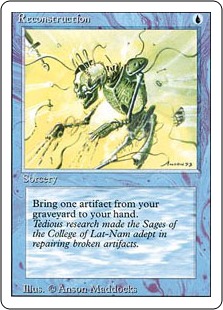

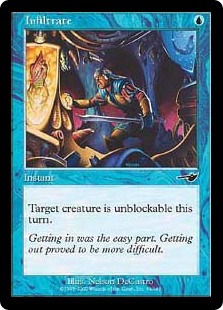
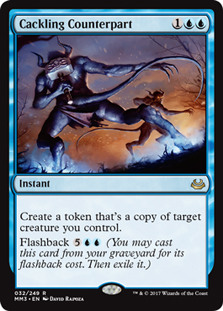
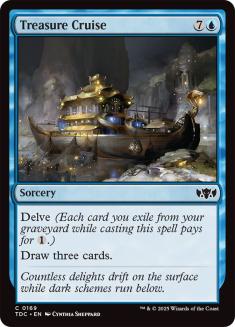

Like Rootwater Diver, the Reconstruction effect is very useful to have. I’m just going to be upgrading it to a better version of the same effect. Neither
Void Snare nor Infiltrate do enough to be worth slots. Cackling Counterpart is getting upgraded to a similar effect with a little more lategame punch. And
last we come to Treasure Cruise, a card that’s only legal in the formats it’s bad in. In all seriousness though, you aren’t set up to fuel delve in any
sort of timely fashion and given some of the cards I’ll be adding later, you don’t really want to be ripping apart your own graveyard.
In:
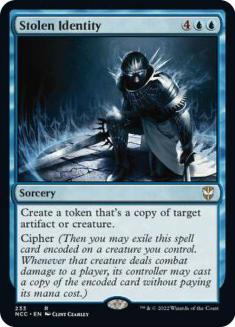

Stolen Identity is getting swapped in for Cackling Counterpart. They both do essentially the same thing, but Stolen Identity can target anyone’s permanents
instead of just your creatures. The ability to copy noncreature artifacts probably would’ve pushed this over the top on its own, but cipher is so much more
powerful of an ability than Flashback when it comes to repeatability. Even putting this on a Thopter token will probably allow you to fire it off a few
times before everyone gets their air shields up, but when its encoded on one of the Colossi or Inkwell Leviathan (remember that cipher doesn’t target, so
sticking this on shroud creatures works just fine), and you’re probably going to run the table over with the tokens you make before people can stop you.
The Enchantments
Out:
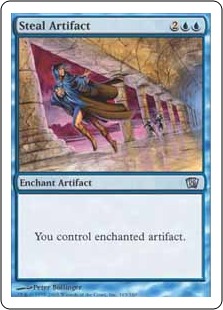
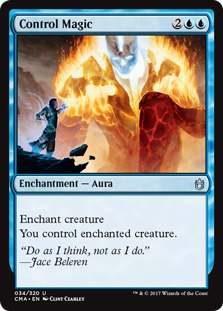
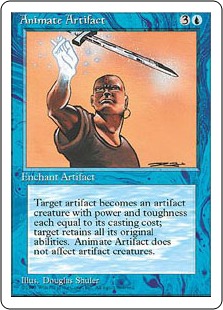
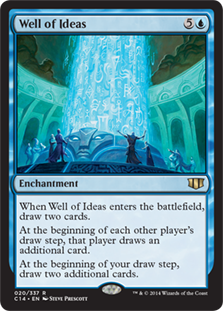

Control Magic and Steal Artifact both get cut because they do the same thing as your commander, and not even the part we’re interested in here. Animate
Artifact gets cut because you don’t have any noncreature artifacts that are expensive enough to be credible threats as vanilla beaters. Well of Ideas came
out to make room for Vedalken Archmage, which will usually draw you more cards without giving anything to your opponents. It also costs two less, which is
far from irrelevant.
In:
Nothing!
I think that Thopter Spy Network and Archetype of Imagination are going to be your only enchantments. There’s an argument for running Thassa to make your
giant Golems unblockable, but I wanted to make room for as many artifacts as possible into your deck. That space had to come from somewhere.
After all the cuts and removing a card to get the list down to a hundred cards, we’ve freed up eleven empty spaces going into the last section. That’s a
pretty radical shift in the balance of your deck, but since we’re building a deck based around the artifact card type, this is what I wanted to aim for.
The Artifacts
Here we get to the real heart of the deck. Mostly I’ll be making additions in this section, but there’s a few cards getting upgraded as well.
Out:
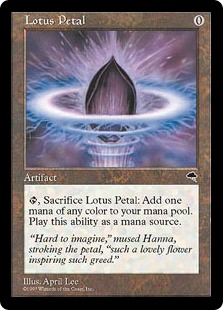
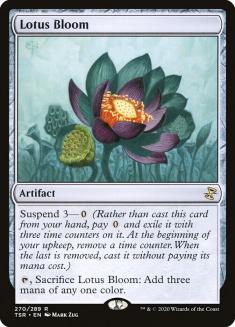
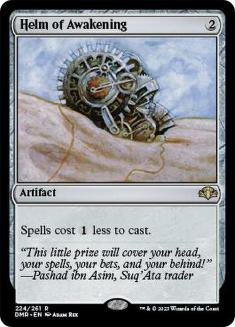

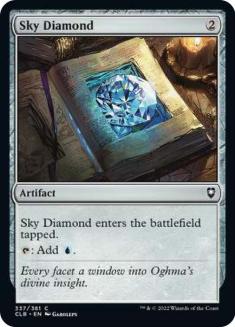
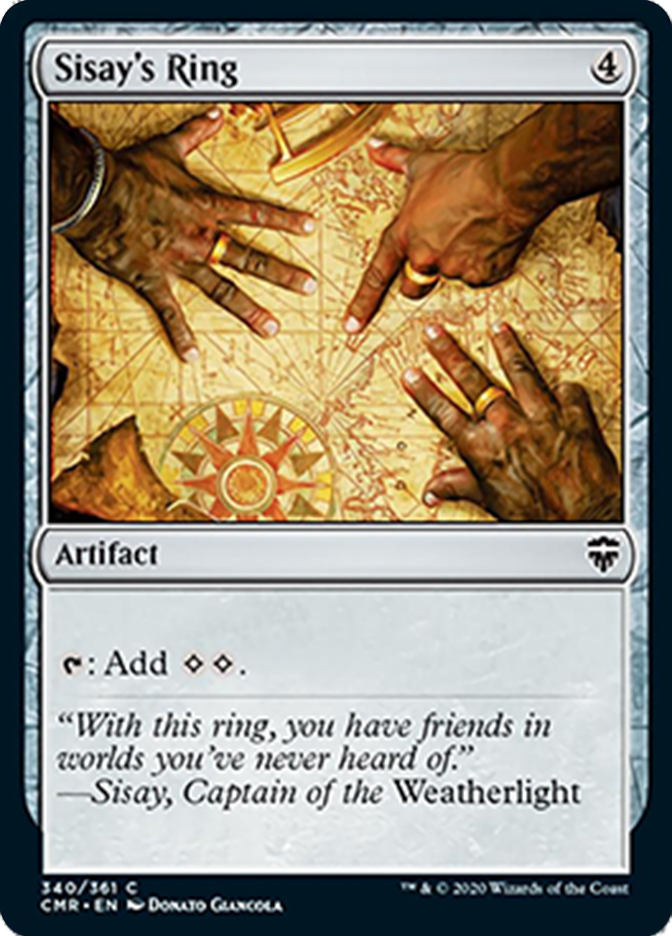

Mana rocks. They’re important, especially to a deck like this. That being said, your choices here are a little odd. I know that hitting big mana is
important to your endgame, but when you aren’t aiming for a fast combo-kill you’d rather pay more up front for a mana rock that will stick around than one
time effects like Lotus Petal or Lotus Bloom. Helm of Awakening is getting cut for similar reasons. It’s a storm enabler that you’re not really set up to
abuse, and helping your opponents will sometimes cost you the game. You’re not really set up to use Thran Turbine either. While I love that card, it’s
getting cut because your heaviest mana requirements involve actually casting giant spells. Sky Diamond and Sisay’s Ring are both fine cards, but there’s
room to improve them.
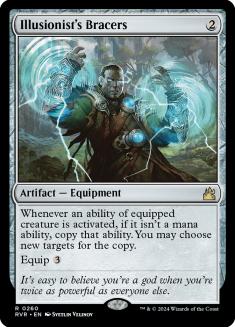

I want to take a moment here to say goodbye to an old friend of mine. This is one of my absolute favorite cards. The first thing I did when Gatecrash came out was trade for literally every copy opened at the Prerelease I went to. And the copies my friends brought back from Prereleases
at other stores. And then I ordered two more from StarCityGames.
The point is, I play this card a lot, but even I don’t think this is the right deck for the Godbracers. They’re relevant on about half a dozen of your
creatures, but it seems like the real reason they were included was to halve the cost of stealing everything with Memnarch. Since that’s exactly what we’re
trying to avoid, they’re getting cut. Most of your important activated abilities aren’t on creatures, so if you really want a card to double abilities it
should be Rings of Brighthearth. I’m not going to add the Rings in because this isn’t really an effect the deck needs, just something that would
be nice, and they’ve more than quadrupled in value since the last time I checked. I’d like to keep this overhaul somewhat on the reasonable side, so we’ll
go in another direction.
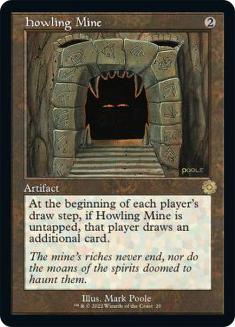
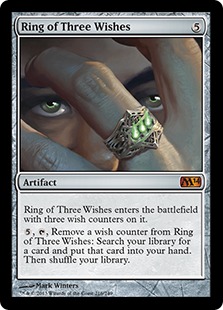
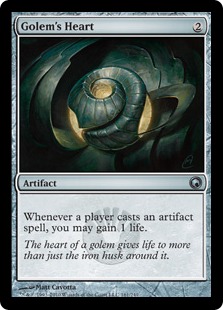
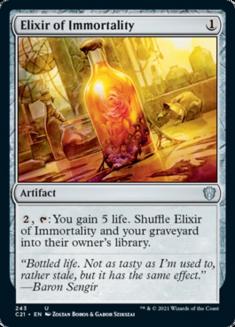

Howling Mine comes out because you don’t really want to be giving your opponents free cards. To be fair, you’re set up pretty well to actually take
advantage of its “if Howling Mine is untapped” clause, but that’s both easy to forget and a very fast way to make enemies when you actually do it. If you
really need card draw this much, there are better options. Ring of Three Wishes is just too expensive. Maybe if you had a proliferate theme I’d keep it,
but as it stands I don’t think you need the Ring. Golem’s Heart gets the axe for being entirely unimpressive. Most of your spells trigger it and everybody
plays artifacts, but the lifegain just isn’t enough to matter. Elixir gets cut because we aren’t in danger of drawing out our deck, and there are better
ways to reuse dead cards.
In:
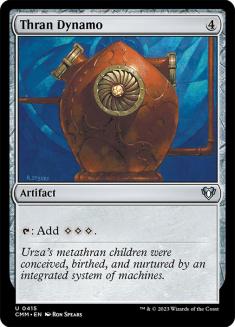
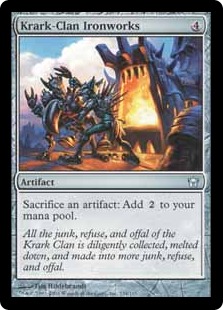
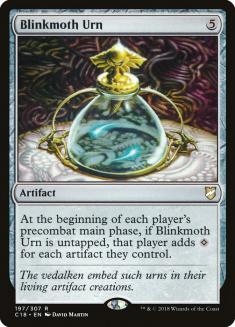

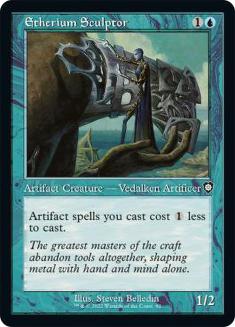
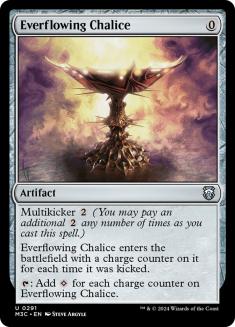
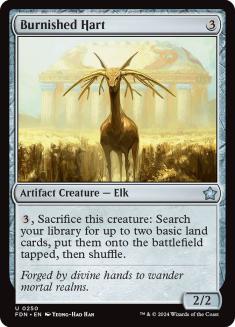
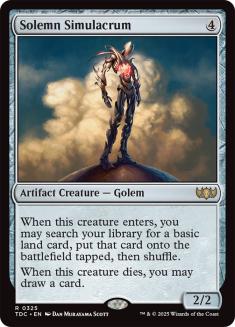

Since I started cuts by taking some of your mana away, let’s start additions by putting it back in. Thran Dynamo is one of the best mana rocks beyond
powerhouses like Sol Ring and Mana Crypt, and if you have something else to do the turn you play it, it essentially only costs you one mana. Krark-Clan
Ironworks is included for two reasons. First, you needed at least one sacrifice outlet in the deck to recur Spine of Ish Sah and protect yourself from your
opponents stealing things. (You do not want somebody else getting their hands on Memnarch against you!) Secondly, in games where you
either have a lot of redundant permanents or want to go all-in on a few big spells, this this can generate truly impressive amounts of mana. Blinkmoth Urn
is about a turn and a half slower than the Ironworks and is theoretically symmetrical, but you don’t have to sacrifice anything and I’m willing to bet that
nobody will be able to abuse its ability anywhere near as well as you can. Etherium Sculptor is the card that Helm of Awakening really wanted to be, since
all your relevant spells are artifacts and he doesn’t benefit your opponents. It’s unfortunate that he is a creature, but see my argument for Vedalken
Archmage as to why running a fragile-bodied creature isn’t really that bad. Everflowing Chalice replaces Sky Diamond. You don’t really care if you have
colorless or blue mana, so the fact that Chalice doesn’t come into play tapped gives it the edge. Lastly we get Burnished Hart and Solemn Simulacrum. The
Hart will usually chump-block once and get sacrificed while the Simulacrum ramps, blocks, and replaces itself. It’s a solid if somewhat expected addition.
In both cases, accessing ramp effects that aren’t impacted by Creeping Corrosion is nice and you have more than enough basics to use them consistently.
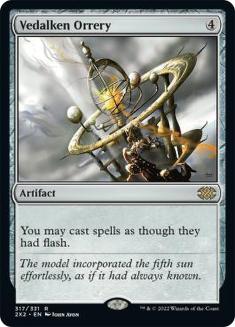
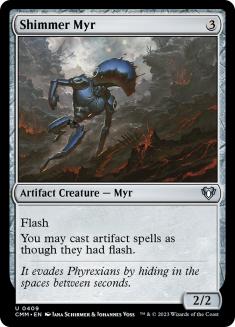

Anything that lets you hold mana up is good, especially since being able to flash in blockers will make people wary about attacking you. Any card with an
enters-the-battlefield trigger gets exponentially better with these effects, and assuming they’re still around they make it much easier to recover from a
sweeper. When you have one of these, it’s usually correct to just pass the turn with all of your mana up and wait for people to do things before reacting.
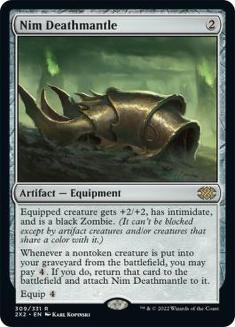
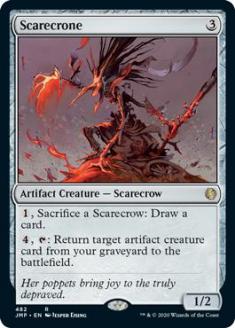

Some pretty solid options for recursion. Both Nim Deathmantle and Scarecrone have their own restrictions, but the ability to bring your creatures back
repeatedly can be fairly backbreaking. Either one can make a very entertaining engine with Burnished Hart (or Solemn Simulacrum and a sacrifice outlet).
Even just the two of them together can turn into pay five mana, draw a card. That’s not a bad way to grind out value if you’re stalled out and not under
immediate pressure. Deathmantle also serves a double purpose of giving your Colossi evasion. Just remember that black creatures can still block them.
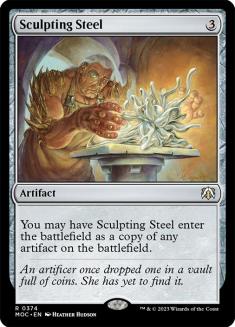
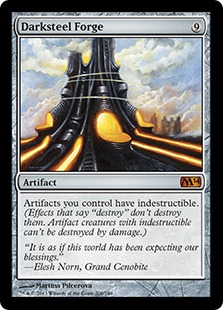
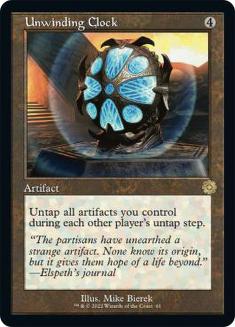
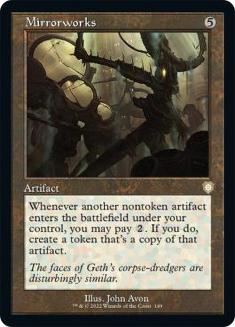
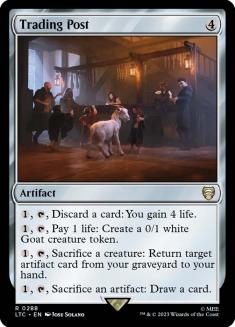
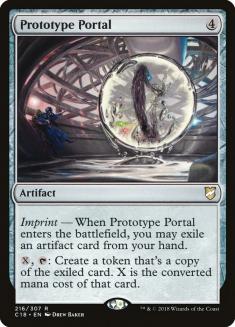


I said early on that a big part of what artifacts are best at is interacting with other artifacts. Clock of Omens and Kuldotha Forgemaster are already very
strong pieces for this strategy. A lot of the cards I’ve added up to this point fall into this category too, like Blinkmoth Urn and Master Transmuter.
These six are the ones included for the sole purpose of making your machine tick better. Sculpting Steel was a fairly obvious inclusion since you’re
already running Phyrexian Metamorph and Clever Impersonator. Darksteel Forge is the effect you wanted from Soul of New Phyrexia. It’s a one-time investment
and then it just sticks around, no mana necessary. By this point it should be pretty obvious that the difference between “permanents” and “artifacts” in
this deck is pretty negligible, and Memnarch can help out by turning your lands and other permanents into artifacts if the need arises. Unwinding Clock
will at the very least give your creatures pseudo-vigilance, but with numerous mana rocks, Master Transmuter, and especially Clock of Omens, it’ll
occasionally let you generate insane value before you even get back to your turn. Mirrorworks lets you double up on any artifact you play for an additional
two mana, which can let you do everything from destroy two permanents with Spine of Ish Sah to generate a massive army of Thopters with double Sharding
Sphinxes. Trading Post is one of the most versatile cards in Magic’s history, and I’d run it here even if you didn’t have the ability to repeatedly untap
it. Most of the time you’ll want to alternate between making Goats and sacrificing them to do their best Rootwater Diver impression, but drawing cards is
never irrelevant and the lifegain ability can be huge in a pinch. I shouldn’t need to say anything more than “Phyrexian Metamorph” to justify the inclusion
of Prototype Portal. Just imagine a gamestate where you’ve made six Trading Posts. Or Mirrorworks. The value this gives you is worth the risk of losing the
imprinted card forever.
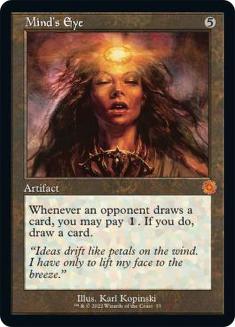
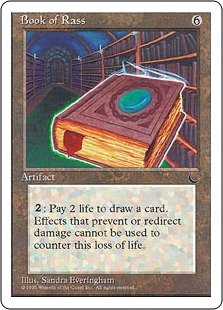

I’ve cut a lot of your card draw out of the deck, and while several of the things I added in will generate you quite a bit of card advantage in most games,
there’s something to be said for the simplicity of the words “draw a card.” Mind’s Eye is a well-known Commander staple that gets better the more mana you
have laying around. It will get blown up, but it will rarely do so before it draws you a new handful of cards. Book of Rass is anything but a staple. A
colorless Greed from the dim days of Magic’s distant past, I’m willing to bet that most people have never even heard of this card. That doesn’t stop it
from being powerful though. Usually it will play just like Greed, drawing you a card here and there when you have some leftover mana. But there will be a
few special games where you’ll have a Shimmer Myr or Vedalken Orrey in play, a big enough life buffer to take some chances, and enough mana to draw a
double handful of cards at the end of your opponent’s turn, dump a bunch of threats into play, and win on your turn.
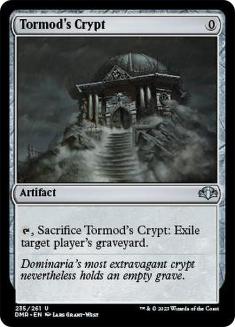
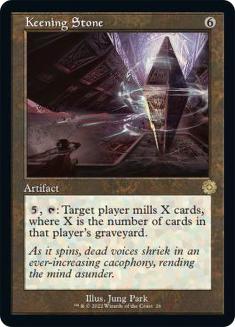

The last two additions to the artifact section aren’t particularly exciting. People like to play with giant graveyards, so sometimes it’s nice to punish
them for it. I picked Tormod’s Crypt over Relic of Progenitus because you’ve got a few ways to bring stuff back from your own graveyard; I’d rather not
disrupt what’s going to be an active resource in most games. Additionally, the ability to get the Crypt back repeatedly with Trading Post will occasionally
prove relevant. Keening Stone is a pet card of mine, and if you ever face a truly dedicated graveyard deck it will sometimes just drop out of the sky and
kill them on the first activation. That on its own wouldn’t be enough to justify running it, but you have enough ways to repeatedly untap and reuse the
Keening Stone that you will sometimes be able to mill someone out in a single turn or pass around the table. Against players that don’t run the original
Eldrazi legends it’s an alternate win condition that few people will see coming.
The Lands
No big changes here. You’re running 36 lands, which is about where you want to be with a high curve and a lot of ramp, so I’m just making a few alterations
to help things flow better.
Out:
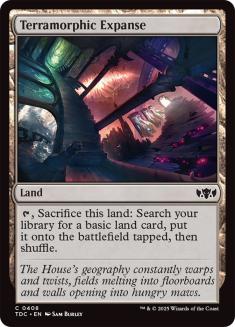
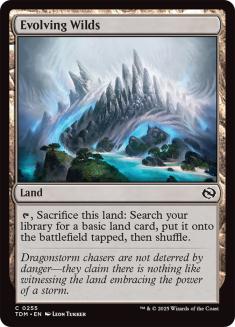
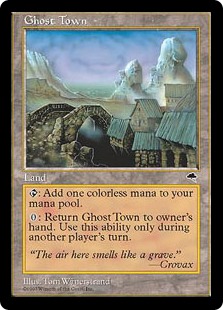

Terramorphic Expanse and Evolving Wilds are fine cards, but you’re a mono-colored deck and don’t have any reason to want to shuffle your deck. These are
functionally just going to be Islands that enter the battlefield tapped. Ghost Town is a strange choice unless your metagame is full of mass land
destruction. Its ability is limited to keep you from ramping with it, so I’m cutting it for something with more relevant utility.
In:


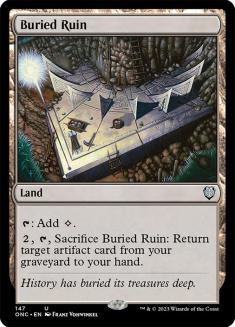

We’re trading two basics that enter tapped for two that don’t. Pick your favorite artwork and go. Buried Ruin is the card that’s replacing Rootwater Diver
and Reconstruction for returning artifacts once, and it doesn’t even take a spell slot to play.
After changes, we’re left with this deck:
Creatures (27)
- 1 Darksteel Colossus
- 1 Solemn Simulacrum
- 1 Memnarch
- 1 Vedalken Archmage
- 1 Vedalken Engineer
- 1 Pentavus
- 1 Arcum Dagsson
- 1 Scarecrone
- 1 Etherium Sculptor
- 1 Master of Etherium
- 1 Sharding Sphinx
- 1 Faerie Mechanist
- 1 Inkwell Leviathan
- 1 Master Transmuter
- 1 Grand Architect
- 1 Kuldotha Forgemaster
- 1 Riddlesmith
- 1 Shimmer Myr
- 1 Phyrexian Revoker
- 1 Blightsteel Colossus
- 1 Phyrexian Metamorph
- 1 Burnished Hart
- 1 Colossus of Akros
- 1 Archetype of Imagination
- 1 Muzzio, Visionary Architect
- 1 Clever Impersonator
- 1 Whirler Rogue
Planeswalkers (1)
Lands (36)
- 1 Mishra's Factory
- 16 Island
- 1 Stalking Stones
- 1 Remote Isle
- 1 Svyelunite Temple
- 1 Temple of the False God
- 1 Urza's Tower
- 1 Urza's Power Plant
- 1 Urza's Mine
- 1 Crystal Vein
- 1 Seat of the Synod
- 1 Lonely Sandbar
- 1 Quicksand
- 1 Darksteel Citadel
- 1 Ghost Quarter
- 1 Buried Ruin
- 1 Rogue's Passage
- 1 Radiant Fountain
- 1 Tomb of the Spirit Dragon
- 1 Foundry of the Consuls
- 1 Mage-Ring Network
Spells (35)
- 1 Counterspell
- 1 Sol Ring
- 1 Fellwar Stone
- 1 Capsize
- 1 Darksteel Forge
- 1 Krark-Clan Ironworks
- 1 Sculpting Steel
- 1 Gilded Lotus
- 1 Arcane Denial
- 1 Vedalken Orrery
- 1 Clock of Omens
- 1 Mind's Eye
- 1 Blinkmoth Urn
- 1 Book of Rass
- 1 Mind Stone
- 1 Interdict
- 1 Worn Powerstone
- 1 Thran Dynamo
- 1 Fact or Fiction
- 1 Spellbook
- 1 Tormod's Crypt
- 1 Expedition Map
- 1 Everflowing Chalice
- 1 Keening Stone
- 1 Sword of Body and Mind
- 1 Prototype Portal
- 1 Nim Deathmantle
- 1 Spine of Ish Sah
- 1 Mirrorworks
- 1 Unwinding Clock
- 1 Swiftfoot Boots
- 1 Trading Post
- 1 Stolen Identity
- 1 Disdainful Stroke
- 1 Thopter Spy Network

For participating in this week’s article you will get $20 in store credit to StarCityGames.com. That’s enough to cover more than a fifth of the changes we’ve made here, which totaled $93.51. That
number could be brought down pretty easily by finding replacements for the six most expensive cards or so, or you could go really wild and add more
expensive options like Metalworker and Rings of Brighthearth. I tried to have a little restraint in that camp, so here’s how it all breaks down:
| CARD: | PRICE: |
| 2x Island | $0 |
| Tormod’s Crypt | $0.25 |
| Book of Rass | $0.25 |
| Burnished Hart | $0.29 |
| Everflowing Chalice | $0.29 |
| Buried Ruin | $0.49 |
| Sharding Sphinx | $0.49 |
| Etherium Sculptor | $0.49 |
| Trading Post | $0.49 |
| Stolen identity | $0.49 |
| Inkwell Leviathan | $0.75 |
| Grand Architect | $1.09 |
| Vedalken Archmage | $1.15 |
| Shimmer Myr | $1.15 |
| Prototype Portal | $1.39 |
| Blinkmoth Urn | $1.49 |
| Mirrorworks | $1.89 |
| Nim Deathmantle | $1.99 |
| Muzzio, Visionary Architect | $2.19 |
| Vedalken Orrery | $2.29 |
| Keening Stone | $3.15 |
| Krark-Clan Ironworks | $3.29 |
| Solemn Simulacrum | $4.19 |
| Unwinding Clock | $4.39 |
| Arcumn Dagsson | $4.39 |
| Darksteel Forge | $4.45 |
| Thran Dynamo | $6.19 |
| Sculpting Steel | $6.45 |
| Darksteel Colossus | $8.05 |
| Master Transmuter | $8.35 |
| Mind’s Eye | $9.35 |
| Scarecrone | $12.35 |
| Total | $93.51 |
Ed, I hope I did the deck justice and gave your Sliver Hivelord deck some decent competition. More importantly, you now have a Memnarch deck that’s capable of more than just stealing the whole board, a fairly unusual sight. I don’t know who’s going to be taking over the column next week, but thanks to Jess, Sean, and the whole crew for letting me take their creation out for a spin! I hope to see you all again when the dust settles, but in the meantime, Dear Azami is still looking for authors. Anyone who’s interested should email dearazami AT gmail.com and let them know.
Want to submit a deck for consideration to Dear Azami? Only one deck submission will be chosen per article, but being selected for the next edition of Dear Azami includes not just deck advice but also a $20 coupon to StarCityGames.com!
Email us a deck submission using this link here!
Like what you’ve seen? Feel free to explore more of “Dear Azami” here, in the Article Archives!
